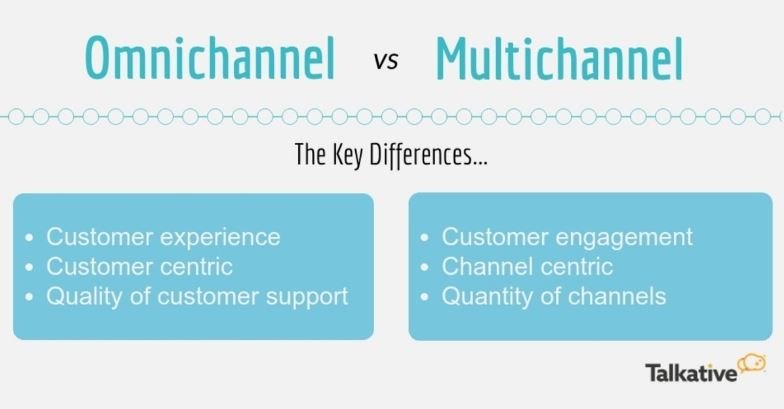Omnichannel vs Multichannel: Why It Matters for CX Surveys

While many of us will be familiar with the term customer experience (CX) and its importance to driving brand loyalty and revenue, our understanding of the concepts used to describe channels of communication with customers is less likely. Yet, they are crucial, and these communication channels need to be right if we’re to effectively engage and deliver the quality of experience customers’ demand.
When it comes to the ways in which we communicate with customers there are two main concepts, omnichannel and multichannel. Within these frameworks there are also marketing and customer contact channels.
While marketing channels refer to the different medium’s brands use to grow awareness and promote their products and services, such as through websites or advertising billboards, contact channels focus on the media customers use to get in touch with businesses. This could include anything from phone and email to live chat and social media.
What’s interesting is that marketing and customer contact channels can both use the same media interchangeably. For example, while email can be used to help nurture prospects as part of a wider marketing campaign, this medium is also effective for answering and resolving customer questions and issues. So, it’s always good to have this dual functionality of channels in mind when you’re communicating with customers.
However, while marketing and customer contact channels can be used interchangeably, it’s important to note that this is not the case when it comes to multichannel and omnichannel concepts, with one better suited to supporting CX than the other. But before we go on to explore why, we need to provide an explanation of each approach.
What does multichannel mean?
When we refer to Multichannel, we’re essentially talking about the use of more than one channel to communicate or market information about a brand. These multiple channels are not integrated with one another. So, an advertising billboard, for example, is not directly connected to an organisation’s website, with each channel working independently of each other to increase awareness of a brand.
What does omnichannel mean?
While omnichannel also employs more than one channel to communicate with customers, under this approach all the channels are integrated to create a seamless experience for the customer. In other words, it allows a customer to pick up on one channel, exactly where they left off on another.
So, in a customer service scenario, you could see a customer service representative initially interacting with a customer via live chat, before escalating that to a video chat, if they needed more detailed information to resolve the issue. With the two channels fully integrated, the customer would not have to repeat the information they shared in the live chat when switching over to video, offering them a smooth, seamless experience.
From the phone, websites, live chat and video calls, to email, SMS and social media channels. Given the growing number of touchpoints with which customers can communicate with a business over the lifecycle of their relationship with them, such integration is crucial to maintain and improve the customer experience.
Differences when running customer surveys
It’s important to know the differences between these approaches, as it can make a real difference when it’s time for you to survey customers with one approach more suited to engaging customers and the other improving customer experience.
If you’re running customer surveys, it’s crucial to be aware of this if you’re to fully realise what you set out to achieve.
There are three main differences to consider.

Customer engagement v customer experience
One of the biggest differences between the two is in how they impact the customer.
While multichannel is focused on engaging customers, omnichannel is aimed at improving the customer experience.
So, while the focus of multichannel marketing is to cast the net as wide as possible and make as many people aware of a business as possible, under the omnichannel approach, the aim is to create a consistent customer experience for people who are already aware of and engaging with a business.
Therefore, if you took the scenario of social media for example. Under the more engagement focused approach of multichannel, the aim would be to get as many followers, likes, shares and comments to your page and posts as possible to show that more people were engaging with your brands. In contrast with an omnichannel strategy, you would be more concerned with ensuring customers could jump seamlessly from your social media page to another medium such as your website. You would also want to ensure that the customer received the same high-quality experience on each platform.
Channel focused v customer focused
Another key difference between omnichannel vs multichannel, is that while the multichannel approach is more channel focused, omnichannel is more concerned with customers.
The aim of multichannel, particularly within marketing is to maximise the number of channels used to promote a brand. So, the more channels offered, the more choice the customer has over how they choose to engage with a business.
In contrast, with omnichannel, the customer, not the channel is the focus. With the customer at the centre, the aim is to deliver a seamless experience as they go from one channel to another, removing the friction as they move between different touchpoints. Under this approach, fewer interconnected channels are viewed as better than having more unconnected channels.
So, if we looked at the example of a retail setting, a multichannel focused approach could involve a large number of channels, such as anything from digital marketing including websites, SEO and paid channels, to billboards, TV and radio adverts, emails and social media. By contrast, an omnichannel approach could involve just half of these channels, such as websites, phone, email and social media, with all of these synced up so customers can seamlessly move from one to the other.
Quantity v quality
The final difference between the two approaches concerns the number of contact channels used versus the quality of support offered through those channels.
As we have already discussed, multichannel is all about increasing the number of channels available. The belief here is that the more channels offered, the better, as it increases reach and gives customers greater choice about how to engage with a business. However, these channels are less likely to be linked up, meaning customers have to start from the beginning whenever they switch from one channel to another, which can hinder the quality of support received.
In contrast omnichannel is more geared towards the quality of support. So, while customers can still choose from a range of available channels, the fact that they are fully integrated means the quality of support they receive will be the same whatever channel they choose. And this quality is maintained, even if they have to switch channels during a support issue.
When you link all this back to surveys and survey distribution methods in particular, it’s vital to be aware of the main differences between the two approaches, if you’re to fully realise the value of running customer surveys.
So, if you’re looking to improve your customer experience, you would be better off using the omnichannel approach, as opposed to the multi-channel approach, which is better suited to creating more noise and awareness around your brand.
Benefits of an omnichannel approach
Having settled on the fact that the omnichannel approach is the best one for improving your customer experience, it’s helpful to be aware of its wider benefits.
So, we’ve listed some key one’s for you below.
More opportunities to collect data and keep improving
The great thing about having more touchpoints and channels of communication with customers, is that it provides more opportunities for you to survey them for their feedback. With more information about what they love, want more of or need improved, you can make the changes they really want to see.
Increase in customer satisfaction
As long as all your channels have been integrated effectively and are working together seamlessly, your customers should receive a high-quality customer experience. And if you’re also delivering more of what they want to see, this should ultimately help to drive up your levels of customer satisfaction too.
Improved customer retention, loyalty and sales
With improved levels of customer satisfaction, this should help you to retain more customers, improve customer loyalty and increase sales, with these same customers more likely to buy more from you again in the future.
Increase in turnover
With more customers buying from you including existing customers and those that have been recommended to you by other satisfied customers, your turnover is only likely to increase further.
Why omnichannel is the best approach for progressing your business
When it comes to business success, customer experience is now one of the most important components, even more so than price and product. So, whatever you can do to further improve your customer experience, you need to be doing it now.
These days that means being able to respond quickly to your customers across all your touchpoints, on whatever channel they choose to communicate with you on. Currently the best way to achieve this is with the omnichannel approach. If you can do that, you will have a firm platform for moving forward.


